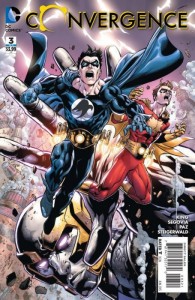 Convergence #3 — Writer: Jeff King; Pencils: Stephen Segovia; Inks: Jason Paz; Colors: John Starr with Peter Steigerwald
Convergence #3 — Writer: Jeff King; Pencils: Stephen Segovia; Inks: Jason Paz; Colors: John Starr with Peter Steigerwald
Convergence: Batman and the Outsiders #1 (of 2) — Writer: Marc Andreyko; Art: Carlos D’Anda; Colors: Gabe Eltaeb
Convergence: The Flash #1 (of 2) — Writer: Dan Abnett; Art: Federico Dallocchio; Colors: Veronica Gandini
Convergence: Green Lantern Corps #1 (of 2) — Writer: David Gallaher; Pencils: Steve Ellis; Inks: Ande Parks; Colors: Hi-Fi
 Convergence: Hawkman #1 (of 2) — Writer: Jeff Parker; Pencils: Tim Truman; Inks: Enrique Alcatena; Colors: John Kalisz
Convergence: Hawkman #1 (of 2) — Writer: Jeff Parker; Pencils: Tim Truman; Inks: Enrique Alcatena; Colors: John Kalisz
Convergence: Justice League of America #1 (of 2) — Writer: Fabian Nicieza; Art: Chriscross; Colors: Snakebite
Convergence: Superboy and the Legion of Superheroes #1 (of 2) — Writer: Stuart Moore; Pencils: Gus Storms; Inks: Mark Farmer; Colors: John Rauch
Convergence: Adventures of Superman #1 (of 2) — Writer: Marv Wolfman; Pencils: Roberto Viacava; Inks: Andy Owens; Colors: Sotocolor
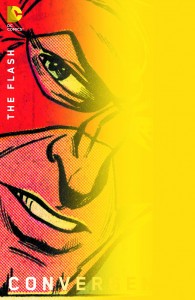 Convergence: Swamp Thing #1 (of 2) — Writer: Len Wein; Art: Kelley Jones; Colors: Michelle Madsen
Convergence: Swamp Thing #1 (of 2) — Writer: Len Wein; Art: Kelley Jones; Colors: Michelle Madsen
Convergence: New Teen Titans #1 (of 2) — Writer: Marv Wolfman; Pencils: Nicola Scott; Inks: Marc Deering; Colors: Jeromy Cox
Convergence: Wonder Woman #1 (of 2) — Writer: Larry Hama; Art/Color: Joshua Middleton
Let’s recap: DC is spending the next two months moving its corporate offices from New York City to California, and they’ve created a two-month event so their regular books don’t have to be published then. The plot is that some  mega-universal, omni-powerful version of Brainiac has created a planet where’s he’s deposited various cities he’s collected from across time and the multiverse, and now they have to fight to see which one wins and gets to not have its universe destroyed. Each week sees an issue of the main Convergence book, plus ten mini-series tie-in. Those are an excuse to revisit characters from different eras: in week one, the viewpoint city for all ten books was Gotham City just pre-new-52, and it was mostly fighting the Flashpoint Gotham (although characters from the Captain Carrot universe, among others, were showing up too); in week two, it was Metropolis from right before Zero Hour (so, about twenty years ago), versus the Kingdom Come timeline, plus a San Diego with many of the Wildstorm characters in it. Now, in week three, we’ve moved back another ten years, to 1984 just
mega-universal, omni-powerful version of Brainiac has created a planet where’s he’s deposited various cities he’s collected from across time and the multiverse, and now they have to fight to see which one wins and gets to not have its universe destroyed. Each week sees an issue of the main Convergence book, plus ten mini-series tie-in. Those are an excuse to revisit characters from different eras: in week one, the viewpoint city for all ten books was Gotham City just pre-new-52, and it was mostly fighting the Flashpoint Gotham (although characters from the Captain Carrot universe, among others, were showing up too); in week two, it was Metropolis from right before Zero Hour (so, about twenty years ago), versus the Kingdom Come timeline, plus a San Diego with many of the Wildstorm characters in it. Now, in week three, we’ve moved back another ten years, to 1984 just  before Crisis on Infinite Earths, and that era’s Gotham City is squaring off against the Tangent universe, the vampire-infested Gotham of Red Rain, and the future-timeline cities of Kamandi and the Atomic Knights. Everybody got that? OK, then…. let’s just mention the alternate-cover trade dress by the amazing Chip Kidd — using a yellow fade this week — and start looking at the actual comics:
before Crisis on Infinite Earths, and that era’s Gotham City is squaring off against the Tangent universe, the vampire-infested Gotham of Red Rain, and the future-timeline cities of Kamandi and the Atomic Knights. Everybody got that? OK, then…. let’s just mention the alternate-cover trade dress by the amazing Chip Kidd — using a yellow fade this week — and start looking at the actual comics:
So, this week’s Convergence #3 continues to follow the Earth-2 superheroes, as they try to evade Telos (the avatar of the battle planet), and end up stumbling into Skartaris, the pocket-dimension world of The Warlord. The good news is that this gets them off of Telos’s radar; the bad news is that their guide turns out to be Deimos, the big bad guy of that series. Meanwhile, Telos uses his persuasive powers on the Kryptonian citizens of Kandor, while the Flashpoint Batman and a Dick Grayson fight villains like Professor 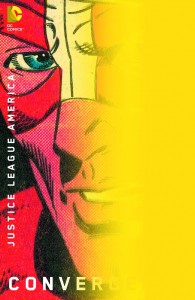 Pyg from the Grant Morrison run on Batman and Robin, and make a number of sacrifices to protect the others. This is all entertaining enough, I suppose, although it still seems to be moving too slowly — I suppose because they’ve still got another seven weeks to go before they can resolve it. Meanwhile, taking the tie-in books in alphabetical order means starting with Batman and the Outsiders. I think DC missed a real bet with many of these issues, by not getting the creators most associated with their original runs on board; a Mike W. Barr script would have been a lot of nostalgiac fun (and Kidd’s selection of a Jim Aparo panel for his cover reminds us all how much of a talent we lost when that great comics artist died). Andreyko and D’Ando do OK with what they’ve got, and show familiarity and affection for the characters, although many of these debut issues have the same plot: Show the characters living under the dome, depowered, and then at the end of the issue drop it,
Pyg from the Grant Morrison run on Batman and Robin, and make a number of sacrifices to protect the others. This is all entertaining enough, I suppose, although it still seems to be moving too slowly — I suppose because they’ve still got another seven weeks to go before they can resolve it. Meanwhile, taking the tie-in books in alphabetical order means starting with Batman and the Outsiders. I think DC missed a real bet with many of these issues, by not getting the creators most associated with their original runs on board; a Mike W. Barr script would have been a lot of nostalgiac fun (and Kidd’s selection of a Jim Aparo panel for his cover reminds us all how much of a talent we lost when that great comics artist died). Andreyko and D’Ando do OK with what they’ve got, and show familiarity and affection for the characters, although many of these debut issues have the same plot: Show the characters living under the dome, depowered, and then at the end of the issue drop it, 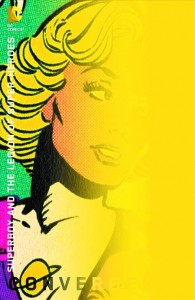 have Telos’s speech, and reveal who they’re going to fight next issue: in this case, the Omac and a bunch of mutants from Kamandi’s world. The Flash is almost exactly the same: show a non-super Barry Allen from a time right after he saw his wife Iris killed and went through a long trial after the death of her murderer, and then at the end drop the dome and reveal his antagonist: the Superman from the Tangent universe. Same deal on the creators, too: Abnett’s script is OK, but it should have been original Flash-scribe Cary Bates, and knowing the Carmine Infantino died two years ago, and will never get to draw the Scarlet Speedster again, is just sad. Green Lantern Corps is from the just-before Crisis period when John Stewart had the ring, Hal Jordan had resigned and Guy Gardner was hanging around; Guy is actually in decent, non-psychotic shape under the dome, but then it drops,
have Telos’s speech, and reveal who they’re going to fight next issue: in this case, the Omac and a bunch of mutants from Kamandi’s world. The Flash is almost exactly the same: show a non-super Barry Allen from a time right after he saw his wife Iris killed and went through a long trial after the death of her murderer, and then at the end drop the dome and reveal his antagonist: the Superman from the Tangent universe. Same deal on the creators, too: Abnett’s script is OK, but it should have been original Flash-scribe Cary Bates, and knowing the Carmine Infantino died two years ago, and will never get to draw the Scarlet Speedster again, is just sad. Green Lantern Corps is from the just-before Crisis period when John Stewart had the ring, Hal Jordan had resigned and Guy Gardner was hanging around; Guy is actually in decent, non-psychotic shape under the dome, but then it drops, 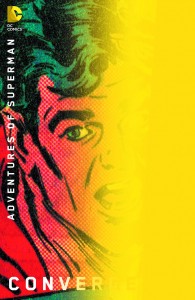 Hal charges up and goes to fight… whomever (maybe the Red Rain vampires?), and nonpowered Guy decided to head for the fight too (here, the nostalgiac creators would have been Steve Englehart and Joe Staton). Hawkman occurs right after the Shadow War mini-series; those creators were Tony Isabella and Richard Howell. Isabella and DC have been on the outs for years (because of the company’s denial of his full rights to his creation Black Lightning, among other things), so his scripting wasn’t in the cards; Jeff Parker at least adds a little more to the story than simply the dropping of the dome, by flashing ahead to the series’ possible endgame. Howell’s absence turns out to be OK simply because of his substitute: the great Tim Truman, who drew the Hawkworld series a few years later, and so has a suitable link to the character; his art makes this one of the better books of the
Hal charges up and goes to fight… whomever (maybe the Red Rain vampires?), and nonpowered Guy decided to head for the fight too (here, the nostalgiac creators would have been Steve Englehart and Joe Staton). Hawkman occurs right after the Shadow War mini-series; those creators were Tony Isabella and Richard Howell. Isabella and DC have been on the outs for years (because of the company’s denial of his full rights to his creation Black Lightning, among other things), so his scripting wasn’t in the cards; Jeff Parker at least adds a little more to the story than simply the dropping of the dome, by flashing ahead to the series’ possible endgame. Howell’s absence turns out to be OK simply because of his substitute: the great Tim Truman, who drew the Hawkworld series a few years later, and so has a suitable link to the character; his art makes this one of the better books of the  week. Justice League of America is from the “Justice League Detroit” era of that book, which gets mocked a lot, although in addition to the “new” recruits — Gypsy, Vibe, Steel and Vixen — there was Aquaman, Martian Manhunter, and Elongated Man Ralph Dibney and his wife Sue, so it wasn’t as barren as we remember it. Here, they’re up against the Secret Six from the Tangent universe, and the Chriscross art makes it a little better than average.
week. Justice League of America is from the “Justice League Detroit” era of that book, which gets mocked a lot, although in addition to the “new” recruits — Gypsy, Vibe, Steel and Vixen — there was Aquaman, Martian Manhunter, and Elongated Man Ralph Dibney and his wife Sue, so it wasn’t as barren as we remember it. Here, they’re up against the Secret Six from the Tangent universe, and the Chriscross art makes it a little better than average.
Halfway through: Superboy and the Legion of Superheroes misses a chance to have been special — it should have been by Paul Levitz and Keith Giffen, since it’s from right in the middle of their run — and while Gus Storms’s stylized, wide-eyed art is different, it isn’t enough; it doesn’t help that the team, one of the most powerful in any era, is up against the Atomic Knights. 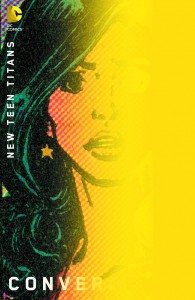 Adventures of Superman has both Superman and Supergirl; she gets a vision of her near future and death in Crisis, and the story’s by that series’s scripter Marv Wolfman, which makes it seem considerably more “real,” and her heroism more poignant. Meanwhile, Wolfman’s old friend Len Wein offers the best book of the week: Swamp Thing. Technically, the writer from this era should have been Alan Moore, but the odds of him working for DC are exactly zero; absent that, Wein, who created the character, is an inspired choice, and he’s paired, not with Bernie Wrightson, but with the next best thing: Kelley Jones, whose similar EC-inspired influences fit perfectly here. Mix in the Red Rain/Batman vampires, and the result is clever, stylish fun, and a reminder of what some of these other titles could have been. New Teen Titans does something similar, in that it snags that group’s longtime
Adventures of Superman has both Superman and Supergirl; she gets a vision of her near future and death in Crisis, and the story’s by that series’s scripter Marv Wolfman, which makes it seem considerably more “real,” and her heroism more poignant. Meanwhile, Wolfman’s old friend Len Wein offers the best book of the week: Swamp Thing. Technically, the writer from this era should have been Alan Moore, but the odds of him working for DC are exactly zero; absent that, Wein, who created the character, is an inspired choice, and he’s paired, not with Bernie Wrightson, but with the next best thing: Kelley Jones, whose similar EC-inspired influences fit perfectly here. Mix in the Red Rain/Batman vampires, and the result is clever, stylish fun, and a reminder of what some of these other titles could have been. New Teen Titans does something similar, in that it snags that group’s longtime 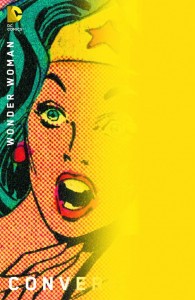 scribe Marv Wolfman; the art, sadly, isn’t by George Perez, although Nicola Scott offers the kind of solid, middle-of-the-road graphics that the Titans’ second series settled into after Perez left. We’re in that era, where Deathstroke’s mute son Jericho and the crystal-manipulating Kole had joined the team, and it’s as good to see Wolfman writing these characters again as it was to see Wein on Swamp Thing. Finally, Wonder Woman is from the Roy Thomas/Don Heck years; Larry Hama is OK as the writer, while Joshua Middleton is actually an improvement over Heck (I never warmed to his art, even when he was doing a number of Marvel titles I liked as a kid), and seeing Diana fight against some of the Gotham City Red Rain vampires — one in particular — makes this a decent issue.
scribe Marv Wolfman; the art, sadly, isn’t by George Perez, although Nicola Scott offers the kind of solid, middle-of-the-road graphics that the Titans’ second series settled into after Perez left. We’re in that era, where Deathstroke’s mute son Jericho and the crystal-manipulating Kole had joined the team, and it’s as good to see Wolfman writing these characters again as it was to see Wein on Swamp Thing. Finally, Wonder Woman is from the Roy Thomas/Don Heck years; Larry Hama is OK as the writer, while Joshua Middleton is actually an improvement over Heck (I never warmed to his art, even when he was doing a number of Marvel titles I liked as a kid), and seeing Diana fight against some of the Gotham City Red Rain vampires — one in particular — makes this a decent issue.
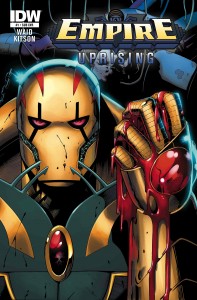 Empire: Uprising #1 — Writer: Mark Waid; Art: Barry Kitson; Colors: Chris Sotomayor
Empire: Uprising #1 — Writer: Mark Waid; Art: Barry Kitson; Colors: Chris Sotomayor
Uncle Scrooge #1 (#405) — Writers: Rudolfo Cimino; Alberto Savini; Romano Scarpa and Luca Boschi; Art: Romano Scarpa; Andrea Freccero; Romano Scarpa
Kaptara #1 — Writer: Chip Zdarsky; Art: Kagan McLeod
This week’s non-Convergence first issues: Empire is a continuation of Waid and Kitson’s series from a few years  ago, about a world where a super-villain has beaten his super-heroic rival and taken over the world; it’s a dark look at absolute power, corruption and the way all the courtiers and hangers-on jockey for influence, and it’s a great deal of fun. Uncle Scrooge is Disney’s re-entry into comics publishing (in partnership with IDW, interestingly, and not Marvel); as you can tell by the credits, they’re heavy on the European creators, but presumably that keeps things cheap: there are 44 full-color pages for $3.99 here, and while there should have been at least one Carl Barks (or at least Don Rosa) reprint, the Italian talent level is
ago, about a world where a super-villain has beaten his super-heroic rival and taken over the world; it’s a dark look at absolute power, corruption and the way all the courtiers and hangers-on jockey for influence, and it’s a great deal of fun. Uncle Scrooge is Disney’s re-entry into comics publishing (in partnership with IDW, interestingly, and not Marvel); as you can tell by the credits, they’re heavy on the European creators, but presumably that keeps things cheap: there are 44 full-color pages for $3.99 here, and while there should have been at least one Carl Barks (or at least Don Rosa) reprint, the Italian talent level is 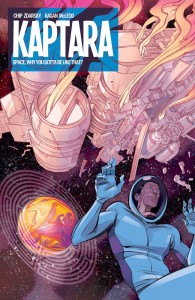 reassuringly high — and the editorial content mentions that, while this is #1, it’s also noted as #405 of the original series, a nice call-back to history. Kaptara is a space adventure, wherein a bio-engineer’s spaceship gets sidetracked and he ends up on a distinctly Masters-of-the-Universe type planet (barbarian warriors fighting against a potentially-galactic tyrant whose name is Skullthor) and tries to make his modern-Earth geek self fit in; the art’s OK (better at imaginative alien creatures than actual people), and Zdarsky’s time with Matt Fraction on Sex Criminals has made him a writer who can combine drama and snarky commentary well, so this is a readable and mildly entertaining first issue.
reassuringly high — and the editorial content mentions that, while this is #1, it’s also noted as #405 of the original series, a nice call-back to history. Kaptara is a space adventure, wherein a bio-engineer’s spaceship gets sidetracked and he ends up on a distinctly Masters-of-the-Universe type planet (barbarian warriors fighting against a potentially-galactic tyrant whose name is Skullthor) and tries to make his modern-Earth geek self fit in; the art’s OK (better at imaginative alien creatures than actual people), and Zdarsky’s time with Matt Fraction on Sex Criminals has made him a writer who can combine drama and snarky commentary well, so this is a readable and mildly entertaining first issue.
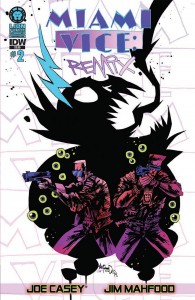 Miami Vice: Remix #2 — Writer: Joe Casey; Art: Jim Mahfood; Colors: Justin Stewart
Miami Vice: Remix #2 — Writer: Joe Casey; Art: Jim Mahfood; Colors: Justin Stewart
The Black Hood #3 — Writer: Duana Swierczynski; Art: Michael Gaydos; Colors: Kelly Fitzpatrick
Satellite Sam #13 — Writer: Matt Fraction; Art: Howard Chaykin
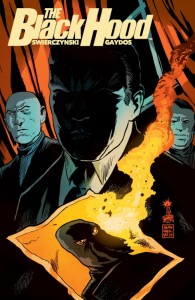 Velvet #10 — Writer: Ed Brubaker; Art: Steve Epting; Colors: Elizabeth Breitweiser
Velvet #10 — Writer: Ed Brubaker; Art: Steve Epting; Colors: Elizabeth Breitweiser
Deadly Class #12 — Writer: Rick Remender; Art: Wes Craig; Colors: Lee Loughridge
The other indy books — I missed Miami Vice:Remix #1 — or looked at it and dismissed it — without realizing that its artist is the astonishing Jim Mahfood (who made Phoenix 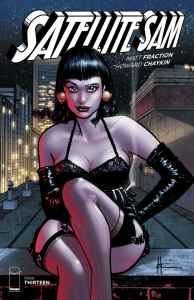 his home for a while, and had a weekly strip in the New Times for a number of years in the early ’00s), who has a unique, loose counterculture style and slapstick sensibility. That tongue-in-cheek flair works well with this bit of ’80s nostalgia; my only complaint is that the coloring and production often make the book too dark and shadowy, when Mahfood’s style (and the southern-Florida look of MV, too) lends itself much better to Day-Glo primary colors instead. Black Hood is shadowy, too, but that works well with both the story (a
his home for a while, and had a weekly strip in the New Times for a number of years in the early ’00s), who has a unique, loose counterculture style and slapstick sensibility. That tongue-in-cheek flair works well with this bit of ’80s nostalgia; my only complaint is that the coloring and production often make the book too dark and shadowy, when Mahfood’s style (and the southern-Florida look of MV, too) lends itself much better to Day-Glo primary colors instead. Black Hood is shadowy, too, but that works well with both the story (a 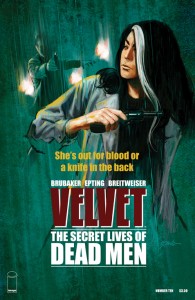 gritty street-level tale about a cop, scarred both physically and psychically, who puts on the mask of a vigilante he’s accidentally killed, and takes over his job) and the art from Gaydos, who contributed a similar noir style a few years ago to both Daredevil and Brian Michael Bendis’s now-hot Alias. Satellite Sam seems to be accelerating towards a climax, and as always it’s the Chaykin art, set in his beloved late ’40s/early ’50s milieu, that makes it cool, while Velvet is
gritty street-level tale about a cop, scarred both physically and psychically, who puts on the mask of a vigilante he’s accidentally killed, and takes over his job) and the art from Gaydos, who contributed a similar noir style a few years ago to both Daredevil and Brian Michael Bendis’s now-hot Alias. Satellite Sam seems to be accelerating towards a climax, and as always it’s the Chaykin art, set in his beloved late ’40s/early ’50s milieu, that makes it cool, while Velvet is  the same smooth Brubaker/Epting tribute to ’60s and ’70s spy thrillers that it’s always been. That leaves Deadly Class, Remender and Craig’s surreal, sleek-looking B-movie romp about angsty adolescent assassins-in-training and their bloody adventures. Like Mahfood, Remender has extensive Phoenix connections, and if you only know him from his Marvel work (Captain America, Uncanny Avengers, etc.), you definitely need to check out his unfettered creator-owned stuff, too.
the same smooth Brubaker/Epting tribute to ’60s and ’70s spy thrillers that it’s always been. That leaves Deadly Class, Remender and Craig’s surreal, sleek-looking B-movie romp about angsty adolescent assassins-in-training and their bloody adventures. Like Mahfood, Remender has extensive Phoenix connections, and if you only know him from his Marvel work (Captain America, Uncanny Avengers, etc.), you definitely need to check out his unfettered creator-owned stuff, too.
 Unbeatable Squirrel Girl #4 — Writer: Ryan North; Art: Erica Henderson; Colors: Rico Renzi
Unbeatable Squirrel Girl #4 — Writer: Ryan North; Art: Erica Henderson; Colors: Rico Renzi
The Black Vortex: Omega — Writer: Sam Humphries; Pencils: Ed McGuinness and Javier Garron; Inks: Mark Farmer, Javier Garron and Ed McGuinness; Colors: Marte Gracia
All-New X-Men #40 — Writer: Brian Michael Bendis; Art: 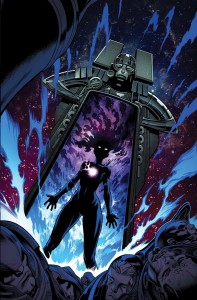 Mahmud Asrar; Colors: Rain Beredo
Mahmud Asrar; Colors: Rain Beredo
Star Wars #4 — Writer: Jason Aaron; Art: John Cassaday; Colors: Laura Martin
Amazing Spider-Man #17.1 — Writer: Gerry Conway; Pencils: Carlo Barberi; Inks: Juan Vlasco; Colors: Israel Silva
Speaking of Marvel stuff: of the five bools from that company here, Squirrel Girl continues to be, improbably, 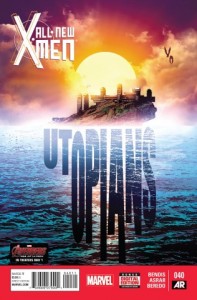 the best: smart, sexy without trying to be, and pure fun. This is exactly the comic everyone means when they say that the mainstream companies need to get more experimental and modern, and attract new readers: so buy it; while it’s had a massively-positive critical reception, sales haven’t matched it yet, and it would be a shame to lose a book with such a unique vision. If it gets cancelled and replaced by some X-Men or Avengers title with an adjective in front of it, you’ll have no one to blame but yourselves. Black Vortex: Omega ends that crossover mini-event; a couple of characters end up with permanent
the best: smart, sexy without trying to be, and pure fun. This is exactly the comic everyone means when they say that the mainstream companies need to get more experimental and modern, and attract new readers: so buy it; while it’s had a massively-positive critical reception, sales haven’t matched it yet, and it would be a shame to lose a book with such a unique vision. If it gets cancelled and replaced by some X-Men or Avengers title with an adjective in front of it, you’ll have no one to blame but yourselves. Black Vortex: Omega ends that crossover mini-event; a couple of characters end up with permanent  power-ups, and Kitty Pryde fans (I know you’re out there, Gina…), will want to get this for a major turning point in her life. It’s also a very good-looking book, because the McGuiness/Garron art team have a flair for both the superheroic poses and the cosmic setting, with a couple of full-page splashes (including two of Kitty) that are just stunning (and helped considerably by Marte Gracia’s coloring). All-New X-Men starts where that comic leaves off, with the space-traveling younger version of the group now reunited and back on Earth; it’s gotten some press because of its revelation that their version of Iceman is gay, courtesy of a nicely-rendered conversation between
power-ups, and Kitty Pryde fans (I know you’re out there, Gina…), will want to get this for a major turning point in her life. It’s also a very good-looking book, because the McGuiness/Garron art team have a flair for both the superheroic poses and the cosmic setting, with a couple of full-page splashes (including two of Kitty) that are just stunning (and helped considerably by Marte Gracia’s coloring). All-New X-Men starts where that comic leaves off, with the space-traveling younger version of the group now reunited and back on Earth; it’s gotten some press because of its revelation that their version of Iceman is gay, courtesy of a nicely-rendered conversation between 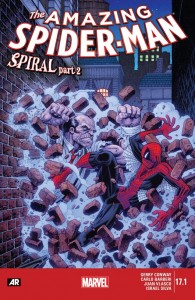 Bobby Drake and Jean Grey — the whole book, in fact, is one of those quiet-conversation lulls that act as effective deserts after a big event (and then, at the end, a new group of badass mutants, with a number of familiar faces in it, is introduced to set up more action for next issue). Star Wars continues to do what it’s supposed to, with Aaron and Cassady providing a comfortable, familiar version of the characters from right after the end of Episode IV, while Amazing Spider-Man is screwing with its numbering (17.1, and it’s really the second issue of a story that started with number 16.1 last month: as a cataloguer, Marvel, it would be more merciful just to shoot me…), while welcoming back longtime Bronze Age scripter Gerry Conway to pit our hero against a number of power-enhanced mobsters like the Goblin King, Hammerhead, Mr. Negative, etc., in a smoothly-told story that hits all the right beats for longtime readers.
Bobby Drake and Jean Grey — the whole book, in fact, is one of those quiet-conversation lulls that act as effective deserts after a big event (and then, at the end, a new group of badass mutants, with a number of familiar faces in it, is introduced to set up more action for next issue). Star Wars continues to do what it’s supposed to, with Aaron and Cassady providing a comfortable, familiar version of the characters from right after the end of Episode IV, while Amazing Spider-Man is screwing with its numbering (17.1, and it’s really the second issue of a story that started with number 16.1 last month: as a cataloguer, Marvel, it would be more merciful just to shoot me…), while welcoming back longtime Bronze Age scripter Gerry Conway to pit our hero against a number of power-enhanced mobsters like the Goblin King, Hammerhead, Mr. Negative, etc., in a smoothly-told story that hits all the right beats for longtime readers.



